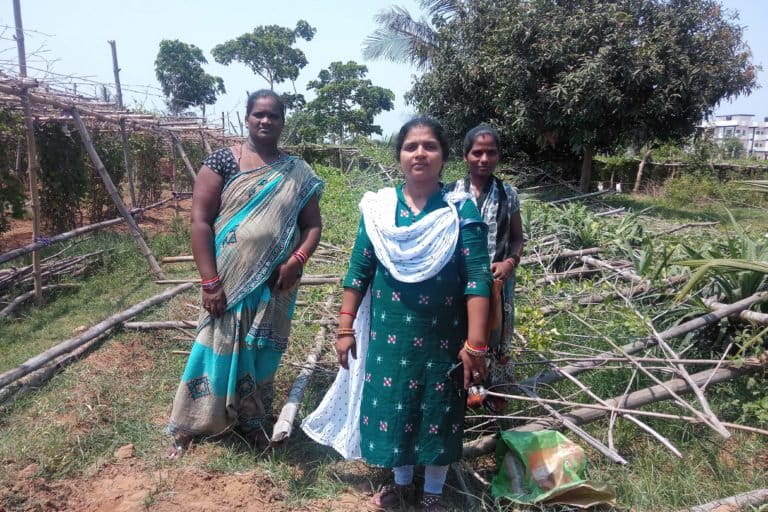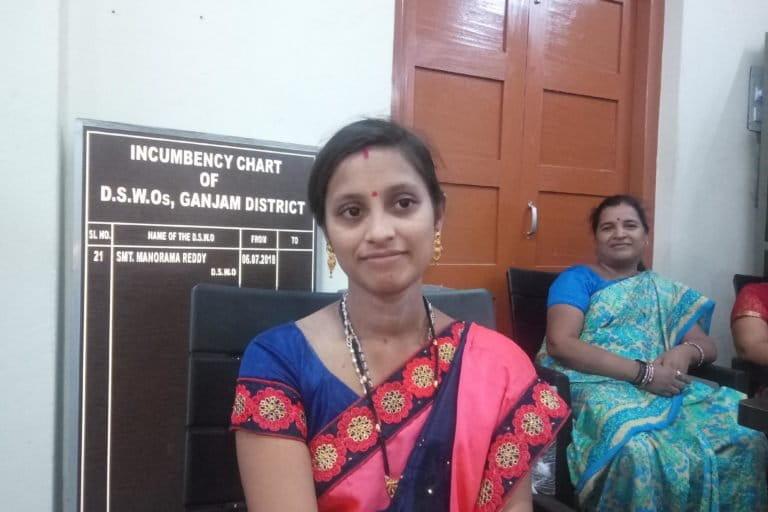- In cyclone-prone Ganjam district in coastal Odisha, a cadre of women has stepped up to lead communities in disaster preparedness.
- A batch of 50 women, who have experienced natural disasters and extreme weather, will be trained by the administration to deal with associated emergencies.
- They will mobilise communities during evacuations and train others to carry the initiative forward.
High-speed winds had smacked into sturdy mango trees and shaken the fruits away. They were all over the ground. Extremely severe cyclonic storm Fani’s dread had barely passed. Rashmi Behera and her friends were busy collecting the fallen mangoes when one of the trees, seemingly weakened by the storm, suddenly toppled.
A severed branch fell on a cow.
Abandoning her pursuit, Behera, a college-going member of one of the 50,000 self-help groups (SHGs) in Odisha’s Ganjam district, rallied her friends and managed to ease the branch off the animal.
“We managed to save her and release her on the field. It was deeply satisfying and the mangoes that we collected were turned into dishes and we ended up savouring them for days thereafter,” Behera recollects with pride.
Behera and 49 of her equally enthusiastic counterparts, between the ages 18 and 35, from various women SHGs, have been handpicked by the Ganjam district administration to be part of its Swayamsidha initiative to train women leaders in disaster preparedness.
“After we acquire basic skills, we can train others in our village and carry it forward. This way we can mobilise communities efficiently during calamities,” Behera told this visiting Mongabay-India correspondent ahead of their training in June.

Maximising potential of women SHGs in disaster risk reduction
Ganjam district’s international claim to fame is linked to the olive ridley turtles. Thousands of these turtles crawl ashore each year from the Bay of Bengal to nest in the rookery at the mouth of the Rushikulya river in the district.
But Ganjam, one of the three most cyclone-prone districts in the state, is also reputed to have strong participation by women in self-help groups, engaged in floriculture, pickling, mushroom cultivation, keora cultivation and other activities, since the late 1990s.
The district administration is banking on these women’s SHG-linked leadership skills and experience with disasters to implement the programme that involves the police, the fire department, forest, agriculture, women and child and health departments.
The departments will impart domain-specific skills in managing exigencies such as cyclone, heatwave, earthquake, droughts, wildfires and snakebites.
Twenty-year-old Behera admits she could not do much during cyclone Titli that struck Odisha in December 2018 as she lacked the confidence to reach out to people. But after becoming a member of a self-help group recently, she became active.
“During Fani we could help save human lives as well as livestock,” Behera beamed. She believes after her training as part of Swayamsidha, she will get better in disaster preparedness and improve upon her past record in disaster relief.
Manorama Reddy, the District Social Welfare Officer, who is steering the programme said the idea is to make individuals self-reliant so they do not have to wait for anybody else to come to their and their family’s rescue in the immediate aftermath of a disaster.
While women’s vulnerability to disasters is underscored, Reddy believes, it is equally important to understand their role and maximise their potential in disaster risk reduction.
Women’s high level of risk awareness, social networking practices, extensive knowledge of their communities, managing natural environmental resources and caring abilities makes them important players of effective risk assessment, early warning, disaster response and recovery actions.

“The 50 trainees will help mobilise communities. People will know whom to contact in emergencies. The trainees will learn the first steps they need to take in emergencies, without putting themselves in harm’s way. Overall, we hope the training will have a domino effect on the other women to volunteer to join the platform,” said Reddy.
Urmila Pradhan, another Swayamsidha select, highlights with an example.
“Say a person is drowning in a river and when we spot that person we too jump in to save that person. Consequently, the rescuer also drowns in the process. If we are trained then we will know how to save that person without going in the water,” Pradhan said.
Odisha, home to 46 million people, has been struck by recorded 128 tropical cyclones in 200 years (1804 to 1999), including the supercyclone of October 28 to 30, 1999, which killed approximately 10,000 people and had a 7.5-metre storm surge.
According to the Intergovernmental Panel on Climate Change (IPCC) while fewer tropical cyclones will form, the global proportion of tropical cyclones that reach very intense (Category 4 and 5) levels will likely increase due to anthropogenic warming over the next century.

The first batch of leaders in the making
While identifying the leaders, the district administration zeroed-in on the most vulnerable pockets of the district. “It helps that they have an understanding of the challenges of the disasters and the scale they can take,” said Reddy.
For instance, S. Jyoti Reddy who works with the district collectorate and is an SHG member, recalls the exercise to move vulnerable groups to shelters during cyclone Titli last December. Whisking the elderly, pregnant women, children and the disabled, away to safety remains a priority.
“We went and rescued pregnant women from flooded areas and gave them cooked meals and dry goods. They accessed health services and medications,” 35-year-old Reddy added.
But Reddy and others in the first batch of 50 trainees, including N. Puspanjali, who worked through cyclone Phailin in 2013 and then in Titli five years later, emphasised that people generally are reluctant to abandon their homes and shift to cyclone shelters or safer spaces.
“If people are suddenly asked to evacuate then they don’t want to leave,” 25-year-old Puspanjali said.
“If there is an emergency then how will the administration come and help (if they are not in the shelters). They can’t possibly go door-to-door. People have to be in one place. They don’t have faith in us,” Puspanjali lamented, adding that the coaching will help her counsel and efficiently convince people to leave.
“This time too (during Fani), getting them to move was a major challenge,” said a flustered Puspanjali.
Adored as “queen of Titli” by her peers, for her bravado in rescuing the elderly and livestock from flooded areas during the cyclone, that eventually won her a recognition from the state government, Mitonjali Gowda is looking forward to learning how to administer first aid to snake-bite patients in the aftermath of a cyclone-related flood.
“After the cyclone when flooding occurs, snakes and insects turn up. If someone is bitten then we do not have the know-how to take care of them,” explained Gowda, who got married barely two days after Fani disrupted life in Odisha on May 3.
Vijay Kulangey, the District Collector and Magistrate, believes creating a cadre-like group for disaster preparedness will instil discipline and more resilience in the participants and in the communities they lead in times of crisis.
“We have designed a special uniform for them which will make them instantly recognisable on the field. A customised disaster management kit will be provided to them. And to ensure sustainability we will train more batches and involve them livelihood support schemes,” Kulangey added.
